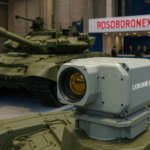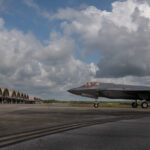The Netherlands signed a letter of intent on October 16 in Washington to join the US Air Force’s Collaborative Combat Aircraft effort. State Secretary for Defence Gijs Tuinman signed at the Dutch Embassy during Defense Industry Days. The Dutch Ministry of Defence described an entry into development work on autonomous uncrewed aircraft that will team with fighters and said the step aligns with its Defence Strategy for Industry and Innovation introduced in April.
Dutch participation covers autonomous “wingmen” intended to extend sensor reach, add weapons capacity, and fly missions in contested airspace alongside aircraft such as the F-35A. Officials said the model aims to speed fielding and lower cost compared with traditional fighter programs. They expect cooperation to expand to Dutch research institutes and companies once technical work matures.
Tuinman told reporters the agreement unlocks “total access” to the CCA program “on all levels,” with Dutch operators set to inject European-theater requirements into configuration choices and employment concepts. He also pointed to a notional model of two wingmen per fighter, a construct that matches ongoing US planning for a large CCA fleet, according to officials.
Defense officials confirm the bilateral framework includes options to jointly develop, test, and evaluate CCA technologies and mission systems to ensure allied interoperability. The Air Force says the initial production decision for Increment 1 remains slated for fiscal 2026.
According to industry sources, early tasks will emphasize mission-system integration, human-machine teaming with mixed F-35 formations, and tactics for operating under electronic attack. Dutch officials signal a push for live trials aligned to the US test cadence at Edwards AFB and with the Experimental Operations Unit at Nellis.
General Atomics and VDL Defentec Agreement on Small Drones
Alongside the CCA letter, the Dutch Ministry of Defence reached a separate agreement with General Atomics Aeronautical Systems on a small uncrewed aircraft system for multi-role intelligence, surveillance, and reconnaissance. The parties describe a platform built for quick deployment and large-scale manufacture, with production capability stood up in the Netherlands from the outset.
VDL Defentec has been selected as the contract manufacturer. General Atomics plans to transfer design, manufacturing, logistics, and support know-how to enable local production. “This contract is the first step in a strategic partnership with the Dutch MoD,” GA-ASI CEO Linden Blue said, linking the work to European defense. Tuinman said the partnership will increase Dutch SUAS capability and technical know-how with a US partner.
The ministry’s notice adds an expected near-term fielding. The smaller drones “should be able to enter service by next year,” giving the armed forces an ISR asset during CCA development. According to officials, the target is a first flight before the end of this year and low-rate production in 2026 in both the United States and the Netherlands. VDL Defentec’s role fixes workshare at home and provides room to expand capacity if allied users request numbers.
This SUAS line sits alongside, not inside, the USAF CCA Increment 1 competition. Dutch officials describe the need for layered systems that can get inside air-defense bubbles for sensing and targeting support, and preserve higher-end assets for the most demanding missions.
CCA Flight Tests and FY26 Production Decision
Both CCA Increment 1 prototypes are now flying. The YFQ-42A, developed with General Atomics, entered Air Force flight testing on August 27. The service characterized the event as a major step toward fielding modular, semi-autonomous aircraft that operate with fifth- and sixth-generation platforms. The campaign includes vendor development work, independent evaluations at Edwards, and operational assessments by the Experimental Operations Unit at Nellis.
The second prototype, Anduril’s YFQ-44A, completed its first flight on October 31 in California. Company officials described the aircraft as semi-autonomous with self-managed flight controls and throttles and automated landing. The Air Force acknowledged the milestone and kept the production-decision schedule in place. Independent reporting confirmed the flight.
US planning calls for a competitive Increment 1 production decision in fiscal 2026. The service previously narrowed industry teams for production-representative prototypes and is running a learning campaign that blends software updates, autonomy maturation, and mission-system swaps. Government statements stress open architectures to permit rapid payload changes and allied integration, enabling partners to add national sensors without disturbing common flight-safety baselines.
The Air Force has publicly confirmed designations. General Atomics’ entry is YFQ-42A and Anduril’s platform is YFQ-44A. Both are in active flight testing. Program officials have also discussed follow-on increments as a venue for tailored use cases with foreign partners, which leaves room for a Dutch configuration in Increment 2 if operational needs diverge from US baselines.
Interoperability and Industrial Participation
The Netherlands fields the F-35A as its primary combat aircraft, which pairs with the CCA focus on manned-unmanned teaming. Ministry language links integrated uncrewed systems to improved effectiveness for manned fighters. In practice, roles include off-board sensing, weapons carriage, electronic attack, and decoy missions under the lead of a crewed jet. The Dutch-US framework aims to co-develop tactics and employment methods that fit European geography and threat laydowns.
Officials confirm the test construct includes operational assessments to validate human-machine teaming, autonomy limits, and command-and-control, producing artifacts allies can reuse. Dutch participation offers feedback from European training areas and NATO exercises, helping align autonomy behaviors with alliance procedures and airspace rules.
The industrial piece is explicit. The Netherlands intends to involve domestic companies and knowledge institutes as cooperation deepens. VDL Defentec’s role on the SUAS is an early anchor. The letter of intent envisions expanding Dutch participation over time and strengthening the national base. That follows a familiar transatlantic model in which partners contribute manufacturing, sustainment, or specialized components, while the US manages core flight-safety and software control.
Exports will depend on program maturity and US approvals, though Dutch placement inside the development stream moves The Hague closer to any procurement queue. Tuinman described the Netherlands as a European entry point for US companies, a view shared in industry given the country’s established F-35 footprint and logistics networks. The combination of a US-led CCA line and a Dutch-built SUAS offers choices across budgets for regional customers facing ISR and air-defense demands.
What the LOI Changes for Near-Term Fielding
Schedules now hinge on the USAF’s FY26 decision and on how fast allied users can stand up units that combine crewed and uncrewed aircraft. The Dutch ministry expects the new SUAS to enter service next year, giving units a tool to practice data fusion, handoff procedures, and autonomy oversight during CCA testing. This gives operators and maintainers a head start before larger wingmen arrive.
Pricing, numbers, and workshare remain to be negotiated, but the public outline is clear. An FY26 production call, an affordability focus, and a fleet large enough to support multiple mission sets. Dutch officials have referenced two wingmen per fighter as a notional pairing, and US commentary has cited a goal around a thousand platforms across the program’s life.
Our analysis shows the LOI places the Netherlands inside the CCA design loop and anchors near-term industry work at home through the SUAS build with VDL Defentec, while flight-proven US prototypes lower adoption risk for allied users.
REFERENCE SOURCES
- https://english.defensie.nl/latest/news/2025/10/16/defence-joins-us-initiative-on-unmanned-air-systems
- https://www.ga.com/ga-asi-and-dutch-ministry-of-defense-sign-agreement-to-develop-new-defense-capabilities
- https://www.af.mil/News/Article-Display/Article/4287627/collaborative-combat-aircraft-yfq-42a-takes-to-the-air-for-flight-testing/
- https://www.reuters.com/business/aerospace-defense/us-defense-company-anduril-flies-its-uncrewed-jet-drone-first-time-2025-10-31/
- https://www.airandspaceforces.com/anduril-cca-first-flight/
- https://breakingdefense.com/2025/10/netherlands-joins-us-for-drone-wingmen-development/
- https://www.fw-mag.com/shownews/756/netherlands-joins-usaf-s-collaborative-combat-aircraft-program
- https://www.businessinsider.com/air-force-first-uncrewed-fighter-jets-photos-2025-3



